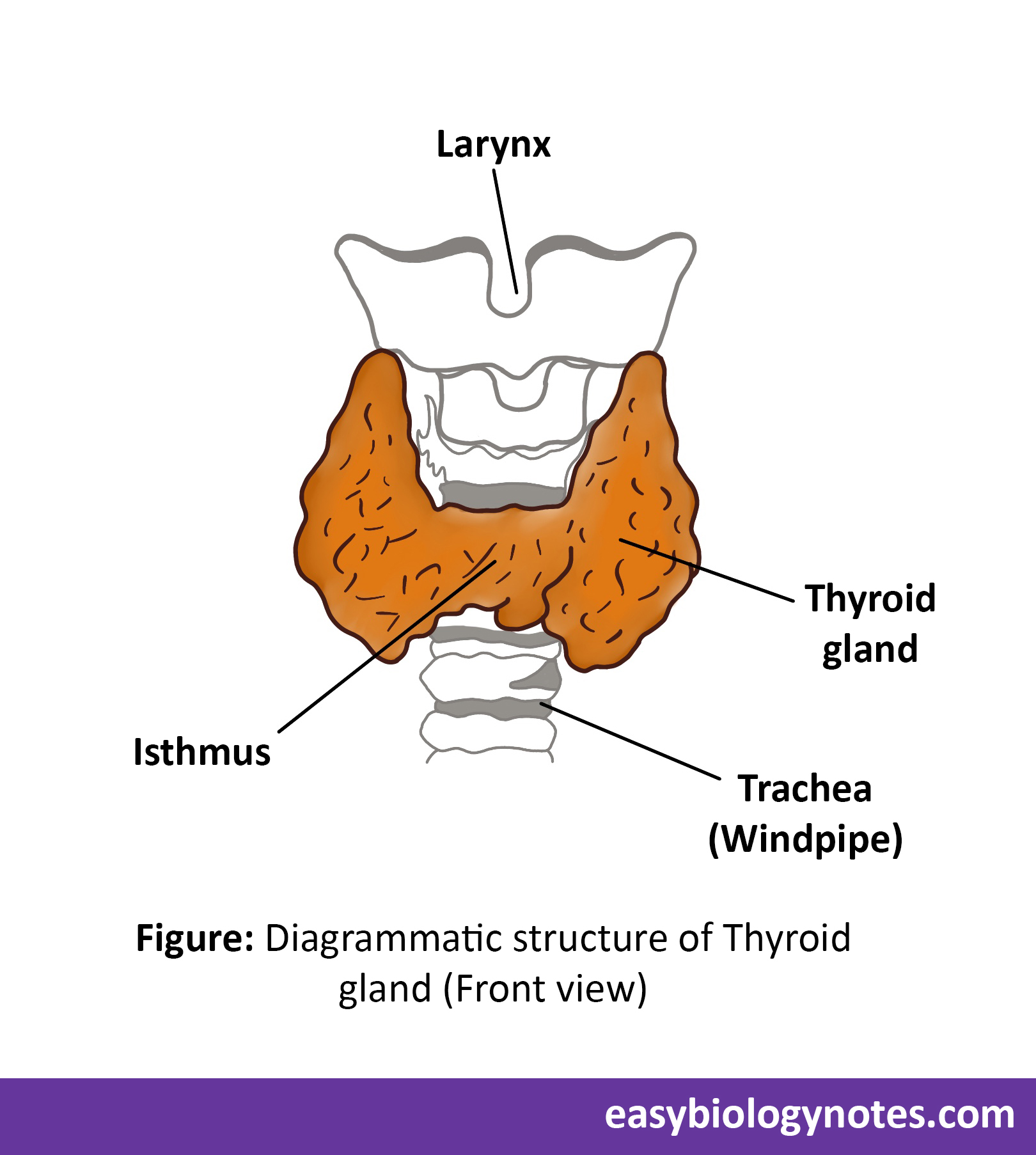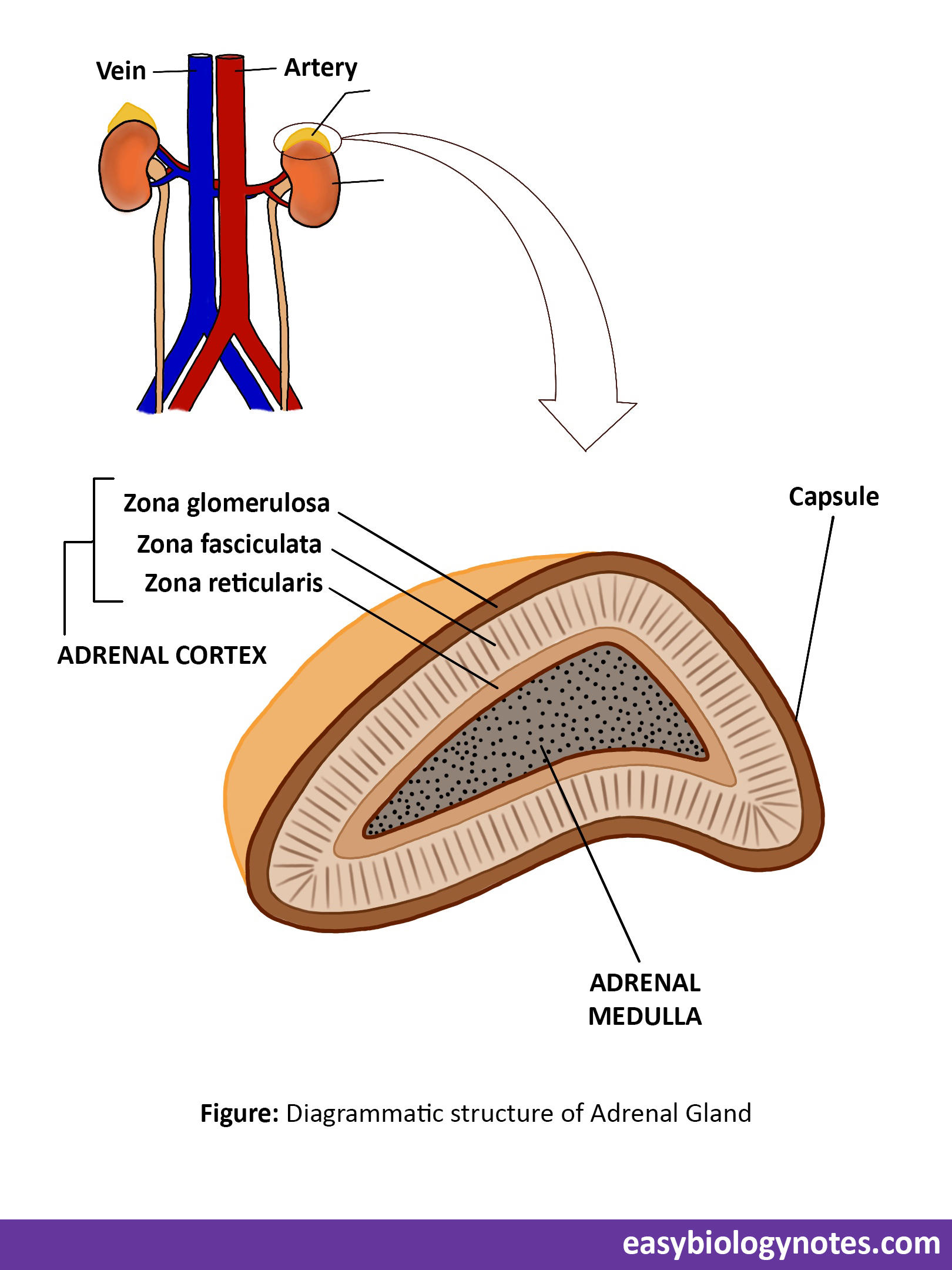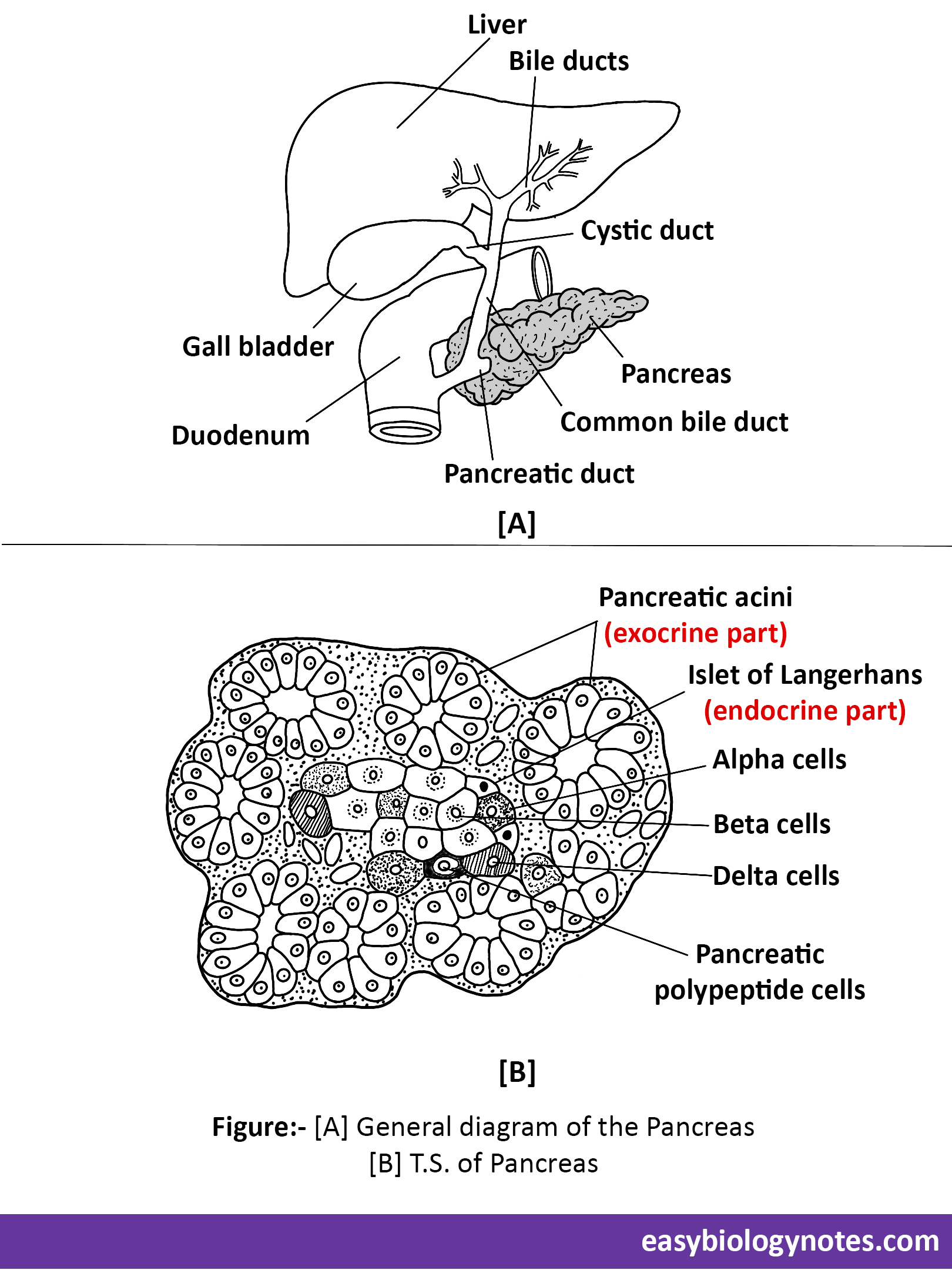What is Endocrine System?
Endocrine System consists of ductless glands that control, communicate, coordinate and integrate various functions of all the body organs by secretions of chemical messenger called hormones.
What is the difference between nervous and endocrine control?
|
Nervous Control |
Endocrine Control |
|
|
1. |
Works by the conduction of nerve impulses. |
Works by the release of chemical messengers – the hormones. |
|
2. |
Works very rapidly. |
Works slowly. |
|
3. |
Nerve impulse is conducted through nerve fibres. |
Hormones travel through bloodstream. |
|
4. |
Effects of nerve impulses are short-lived. |
It has prolonged effect. |
|
5. |
Information is directed to specific part. |
Information is spread throughout the body by bloodstream. |
|
6. |
It has no effect on growth. |
Affects growth. |
|
7. |
Does not influence chemical changes and cannot regulate metabolism. |
It brings about specific chemical changes and regulates metabolism. |
What is the difference between Endocrine glands and Exocrine glands?
|
Endocrine Glands |
Exocrine Glands |
|
|
1. |
Ductless glands. |
Glands with ducts. |
|
2. |
Secrete hormones. |
Secrete enzymes or other useful substances. |
|
3. |
Their secretions always act away from the site of secretion. |
Their secretion may act away or at the site of their secretions. |
|
4. |
Secretions are transported by the way of blood. |
Secretions are transported by the way of ducts. |
|
5. |
Examples – Pituitary gland, Thyroid gland, Adrenal gland, e.t.c. |
Examples – Sweat glands, sebaceous glands, e.t.c. |
Hormones
- Derived from Greek word hormao – to excite.
- A hormone may be defined as a chemical messenger which is secreted in very small quantities by the endocrine glands directly into the blood stream.
- They are also known as information transferring molecules.
- The term hormone was coined by Starling.
- First hormone was discovered by Bayliss and Starling and the hormone was secretin.
Characteristics of Hormones
- Secreted from endocrine glands and transported by the way of blood.
- They always act away from the site of their secretion at particular organ or cell known as target organ.
- They are secreted in very small quantity.
- They are organic compounds of diverse chemical nature and are soluble in water.
- They may accelerate or inhibit specific physiological process.
- They are very specific in their action.
Chemical Nature of Hormones
- Chemically, hormones are as follows :
- Proteinaceous – Example: Follicle Stimulating Hormone (FSH) , Luteinizing Hormone (LH) , Thyroid Stimulating Hormone (TSH)
- Peptides – Example: ACTH, Oxytocin, ADH (Vasopressin)
- Steroids – Sex hormones
- Amino acid derivatives – Thyroxin, Adrenaline
Endocrine glands
- These are ductless glands that control, communicate, coordinate and integrate various functions of all the body organs by secretions of chemical messenger called hormones and thus collectively constitute the endocrine system.
- Target organ cells – Cells or organs that respond to a particular hormone are called target organ cells.
- Endocrinology – The science concerned with the structure and functions of endocrine glands, their diagnosis and treatment of disorders is known as endocrinology.
Endocrine glands in humans
There are mainly two types of endocrine glands -:
- Holocrine glands – The purely endocrine glands whose sole function is to produce hormones. For example : Pituitary gland, Thyroid gland, Adrenal gland, Pineal gland and Thymus.
- Heterocrine gland – The glands which are partly endocrine in function and partly exocrine in function are called heterocrine glands. For example : Pancreas, Gonads (Testes and Ovary), lining of alimentary canal, placenta.
[A] PITUITARY GLAND
-
- It is a small red-grey, pea-shaped gland.
- It lies in the depression of cranium of skull.
- It is attached to the hypothalamus of the brain by a stalk-like structure known as Infundibulum.
Structure of Pituitary
Physiologically the pituitary gland is divisible into three lobes -:
- Anterior lobe or Adenohypophysis
- Intermediate lobe
- Posterior lobe or Neurohypophysis

(a) Anterior pituitary or Adenohypophysis
-
- It has the structure of an endocrine gland.
- It constitutes about 75% of total weight of the gland.
- It is connected with the hypothalamus by the system of blood vessels.
- Growth Hormone (GH) or Somatrotropic Hormone (STH)
- It stimulates the growth of bones and soft tissues of the body.
- Prolactin or Leuteotropic Hormone (LTH)
- It stimulates the mammary glands to secrete milk after the birth of a baby.
- Moreover, it also helps to maintain corpus luteum of ovary after ovulation.
- Thyroid Stimulating Hormone (TSH)
- It stimulates the thyroid gland to secrete hormone thyroxin.
- Adreno cortico trophic hormone (ACTH)
- It promotes and maintains growth and development of adrenal cortex to secrete its hormone.
- Follicle Stimulating Hormone (FSH)
- Also known as Gametokinetic factor – due to its function of gametogenesis.
- In males, FSH helps in the development of seminiferous tubules and spermatogenesis.
- In females, it stimulates ovarian follicle and oogenesis (till the point of ovulation).
- Luteinizing Hormonr (LH) or Interstitial Cell Stimulating Hormone (ICSH)
- LH helps in the process of ovulation and also stimulates growth and development of corpus luteum to secrete its female sex hormones called estrogen and progesterone.
- Growth Hormone (GH) or Somatrotropic Hormone (STH)
(b) Intermediate lobe or Pars intermedia
-
- It is the small middle part of pituitary gland.
- It secretes melanocyte stimulating hormone (MSH).
- MSH controls the distribution of pigments known as melanin in the skin.
- In humans, intermediate lobe is absent and MSH is secreted by hypothalamus.
(c) Posterior pituitary or Neurohypophysis
-
- It has the structure of nervous tissue.
- It serves as a storage area for the two hormones which are produced by the hypothalamus.
- Oxytocin
- Derived from the greek word oxys – swift + tokos – childbirth ; thus it stimulates powerful contractions of the uterus during childbirth.
- It also causes milk ejection from lactating breast by stimulating alveoli that release the milk into the ducts of breast.
- ADH (Anti-diuretic hormone) or Vasopressin
- It prevents the formation of large amount of urine, thus decreases the waterloss from the body (conservation of body water).
- It also raises the blood pressure by bringing about constrictions of blood vessels (Vasoconstriction).
- Oxytocin
*Hypophysectomy – It is the surgical removal of pituitary gland.
*Pituitary as the master gland of the body – It is because of the fact that the pituitary gland controls the functioning of most of the other endocrine glands by the secretion of trophic hormones.
[B] THYROID GLAND
-
- Derived from Greek word thyreo – shield + eidos – shaped.
- Thyroid is the largest endocrine gland (5*3 cm approx.).
- Weighs about 25 gm.
- Position – It lies on the ventral and lateral sides of trachea just below larynx in the neck.
Structure of thyroid gland
- It is brownish-red , butterfly-shaped , bilobed gland , one lobe present on either side of the trachea.
- The two lobes are interconnected by a transverse band made of tissues called isthmus.
- Histologically, thyroid consists of about three million small oval or rounded thyroid follicles.

Hormones of thyroid gland
- It secretes two hormones – Thyroxine and Calcitonin.
- Basal Metabolic Rate (BMR) – It is the rate of cellular oxidation resulting in heat production when the body is at rest. It controls cell respiration and energy production and also helps to maintain the body temperature.
Functions of Thyroxine Hormone
- Calorigenic effect – Thyroxine increases metabolic activities mainly cellular oxidation which results in heat production and energy production. This effect is known as calorigenic effect. So it controls physical, mental and sexual growth of the body.
- Growth and metamorphosis – Thyroxine regulates general growth, development of the body and ossification (transformation of cartilage into bones). It also controls metamorphic changes in amphibians.
Functions of Calcitonin
- It regulates calcium-phosphate levels in the blood.
- It increases calcium deposition in bones and checks osteoporosis (Excessive loss of calcium and phosphorous ions from bones).
[C] ADRENAL GLAND or SUPRARENAL GLAND
Greek word : ad = at +renal = pertaining to kidney
-
- Position – They are two in number present on upper part of each kidney.
Structure of adrenal gland
- Each of the two adrenals are composed of two distinct parts which differ anatomically and functionally which are as follows -:
- Outer portion called Adrenal cortex
- Central part called Adrenal medulla

Hormones of Adrenal Cortex
- Adrenal cortex secretes an entirely different group of hormones called corticosteroids.
- All of them are steroid in nature.
- Physiologically hormones of adrenal cortex are placed into three broad classes as follows -:
1. Mineralocorticoids
-
- Concerned with regulation of mineral metabolism mainly of sodium and potassium, thus maintain water salt balance of the body.
- Example – Aldosterone-It increases the reabsorption of sodium in renal tubule
[*Hypernatremia – Increased level of Na.
*Hyponatremia – Decreased level of Na.
*Hyperkalemia – Increased level of K.
*Hypokalemia – Decreased level of K.]
2. Glucocorticoids
-
-
- They are concerned with carbohydrate, protein and fat metabolism.
- Their secretion is under the control of ACTH.
- Example – Cortisol and Corticosterone.
-
Functions of glucocorticoids
- Effect on carbohydrate metabolism – It promotes the process of gluconeogenesis – the process in which liver cells form glucose from non-carbohydrate precursors (sources) ,i.e. , proteins and fats. It also raises blood sugar levels.
- Effect on protein and fat metabolism – It reduces protein store in all body cells and also decreases the rate of protein synthesis. They also stimulate the formation of fat droplets from fat.
- Effect on lymph and blood – They cause decrease in number of acidophils and lymphocytes thereby reducing the antibody formation.
3. Sex corticoids
-
- They stimulate the development of external sex characters in males.
- Example – Androsterone or Adrenal androgen.
Hormones of Adrenal Medulla
- It secretes catecholamines or emergency hormones.
- Example – Adrenaline (Epinephrine) , nor-adrenaline (nor-epinephrine)
- Both hormone controls all those activities that are under autonomic control and are influenced by sympathetic nerve fibres.
- In general adrenal medulla and sympathetic nervous system function as closely integrated system called Sympathetico-adrenal system.
- Adrenaline also known as emergency hormone – Adrenaline controls the contraction of involuntary muscles including the musclesof heart and arteries. During emergencoes such as emotional stress, fear, fight, excitement, shock and anger , adrenaline is secreted in great amounts. It increases blood flow, causes faster heartbeat to pump more blood providing more oxygen to the tissues which is generally used during increased metabolism of glucose, providing energy and heat production. It also raises body hair, dilates the pupil of eye, increases muscular powers, increases breathing rate, thus it prepares the body for fight or flight reactions.
*Gland of emergency – Adrenal gland:- Adrenal gland is also known as gland of 4 ‘S’s as it controls four functions which start with ‘S’. These functions are :
- Sugar metabolism
- Salt concentration to be kept constant
- Stress and strain controlled by epinephrine
- Sex corticoids control sexual activities
[D] PANCREAS
-
- Pancreas is a heterocrine or myxocrine gland as it contains two types of secretory structures ,i.e. :
- Islets of Langerhans which secrete hormones transported by the way of blood (Endocrine function)
- Acini that secrete pancreatic juice that is transported by the way of ducts (Exocrine function)
- Position – Located just below the stomach in the loop of duodenum of small intestine. It is a flattened, almost triangular structure.
- Pancreas is a heterocrine or myxocrine gland as it contains two types of secretory structures ,i.e. :
Islets of Langerhans
- Endocrine part that is present in the connective tissue of the pancreas.
- Three types of cells are differentiated in the Islets of Langerhans .They are -:
- Alpha cells
- These cells secrete hormone Glucagon.
- Glucagon converts glycogen to glucose (Glycogenolysis) whenever glucose level of the blood decreases.
- Low glucose level in the blood, exercise and protein rich diet stimulate its formation.
- Beta cells
- These cells secrete hormone Insulin that converts glucose to glycogen (Glycogenesis)
- It helps to maintain the blood glucose level constant.
- Delta cells
- These secrete hormone Somatostatin which is a Growth Hormone-Inhibiting Hormone (GH-IH).
- It inhibits the secretion of both glucagon and insulin.
- Alpha cells

[E] Parathyroid gland
- These are four in number present on the ventral surface of the thyroid gland.
- It secretes hormone known as parathyroid hormone (PTH).
- PTH controls calcium and phosphate balance in the body.
- Hyposecretion of PTH causes tetany.
- Hypersecretion of PTH causes Osteltis fibrosa cystica.
[F] Thymus gland
- It is well developed in children whereas it degenerates in old age.
- It produces hormone thymosin concerned with immunity.